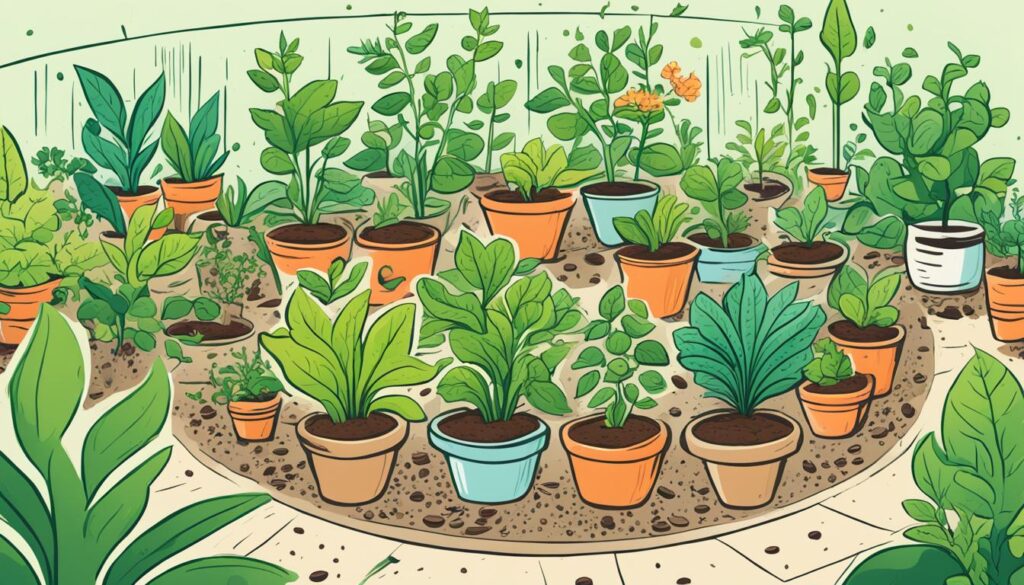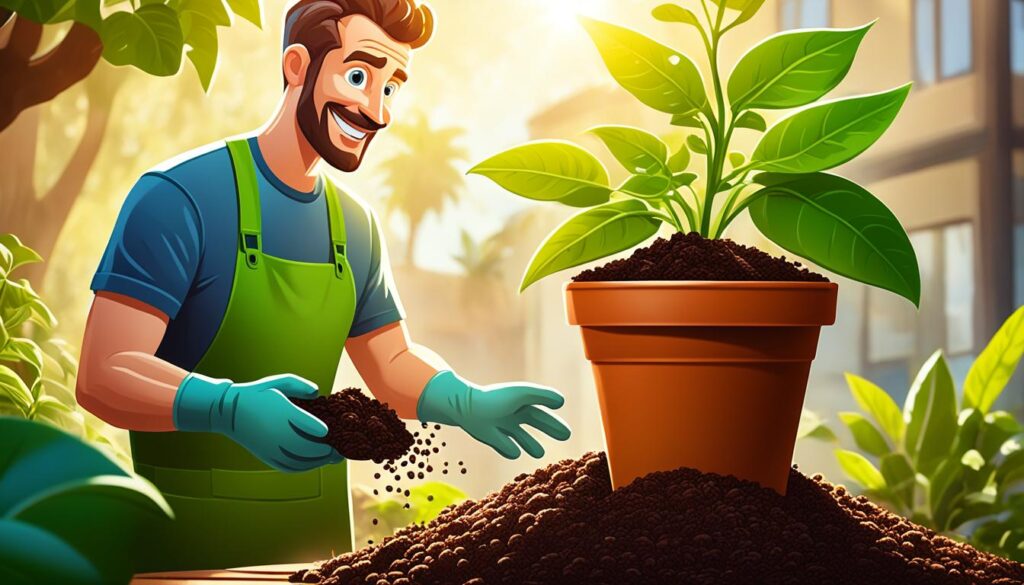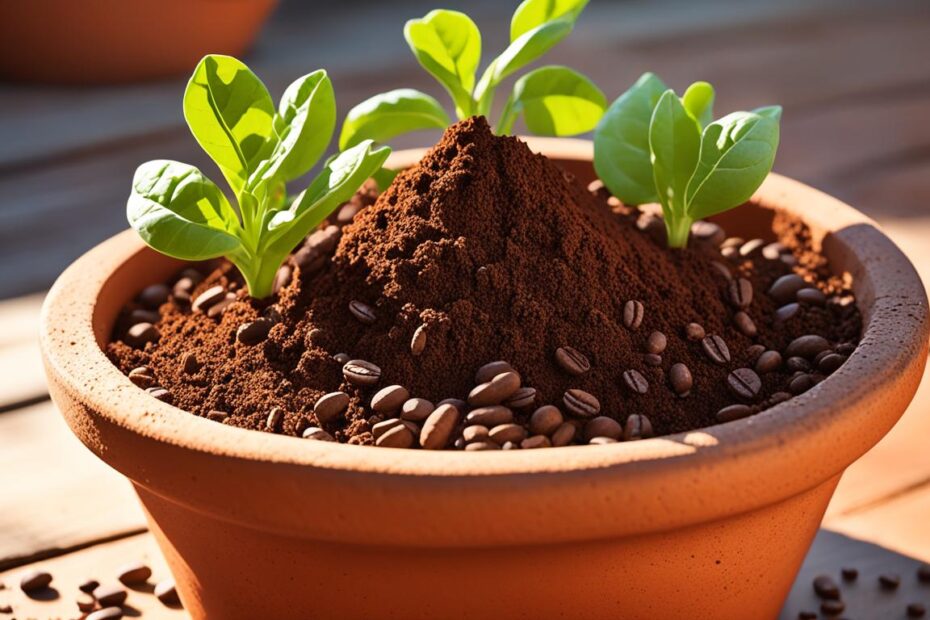Are you looking for a natural and cost-effective way to boost the growth of your plants? Look no further than your morning cup of coffee! Yes, you heard it right. Coffee grounds, those leftover remnants that you usually throw away, can actually work wonders for your potting soil and plant care. But how exactly do coffee grounds contribute to plant growth? And what are the best ways to use them? Let’s unveil the secrets and discover the potential of coffee grounds in potting soil.
Key Takeaways:
- Coffee grounds contain essential nutrients that promote plant growth.
- Used coffee grounds are preferred over fresh grounds to avoid acidity and caffeine.
- Adding coffee grounds to compost or creating a liquid fertilizer can provide nutrients to plants.
- It’s important to use coffee grounds sparingly to prevent water penetration and air circulation issues.
- Coffee grounds should not be the sole source of nutrients for plants.
Using Used Coffee Grounds for Plant Care
When it comes to plant care, used coffee grounds can be a game-changer. They provide numerous benefits for your plants and are an excellent way to repurpose your morning coffee leftovers. By utilizing used coffee grounds, you can enhance your plant’s growth, improve soil quality, and contribute to a sustainable gardening practice.
Unlike fresh grounds, which can be high in acidity and caffeine, used coffee grounds are safe to use on your plants. They offer a range of organic materials that enrich the soil and promote optimal plant growth. When incorporated into compost or used to create a liquid fertilizer, they can significantly impact your plant’s health.
“Used coffee grounds are a rich resource for your plants, providing organic material, aiding water retention, improving aeration, and enhancing drainage.”
Benefits of Using Used Coffee Grounds
When you use used coffee grounds in your plant care routine, you provide essential nutrients and improve the overall health of your plants. Let’s take a closer look at the benefits:
- Organic Material: Coffee grounds add organic matter to the soil, which improves its structure and nutrient-holding capacity.
- Water Retention: The porous nature of coffee grounds helps with water retention, ensuring that your plants receive adequate moisture.
- Aeration: Coffee grounds promote better airflow in the soil, preventing it from becoming compacted and enhancing root development.
- Drainage: The presence of coffee grounds in the soil helps excess water drain away, preventing root rot and waterlogging.
In addition to these benefits, coffee grounds can also help suppress certain pests and diseases in your plants.
Using Coffee Grounds in Your Plant Care Routine
When using coffee grounds, it’s crucial to maintain a balanced approach to avoid any negative effects. Here are some tips to keep in mind:
- Compost or Liquid Fertilizer: Incorporate used coffee grounds into your compost pile or create a liquid fertilizer by diluting them with water.
- Sprinkle Sparingly: If you prefer sprinkling coffee grounds directly on the soil, do so sparingly to prevent water penetration and air circulation issues.
- Balance is Key: Remember that coffee grounds may not provide all the necessary nutrients for your plants. Consider supplementing with additional fertilizers or fresh potting mix.
“Using coffee grounds in your plant care routine requires balance and moderation. Remember to combine them with other nutrients and maintain a well-rounded approach for optimal plant health.”
By incorporating used coffee grounds into your plant care routine, you can harness their benefits and contribute to a healthier, thriving garden. Give it a try and observe the remarkable difference in your plants’ growth and overall vitality!
How to Repurpose Used Coffee Grounds into Fertilizer
Repurposing used coffee grounds into fertilizer is a sustainable and cost-effective way to give your plants a nutrient boost. There are several methods you can use to repurpose coffee grounds and harness their potential as a fertilizer.
1. Composting with Coffee Grounds
One of the most accepted methods is to add used coffee grounds to your compost pile. Coffee grounds are considered a green material and should be balanced with brown materials like vegetable peels, fruit skins, and other natural waste. This will promote decomposition and create nutrient-rich compost.
“Using coffee grounds in compost can help enhance soil fertility and improve overall plant health.”
Once your compost is ready, you can mix a small amount with potting soil and distribute it among your plants. This will provide them with a slow-release source of nutrients.
2. Creating a Liquid Fertilizer
Composted coffee grounds can also be used to create a liquid fertilizer. Simply dilute the composted coffee grounds with water, strain the mixture, and use it to water and fertilize your houseplants.
3. Sprinkling Coffee Grounds on Soil
Another option is to sprinkle used coffee grounds on top of soil as a quick nutrient boost. However, it’s important to do this sparingly to prevent water penetration and air circulation issues. Coffee grounds should be used as a supplement to other fertilizers and not as the sole source of nutrients for your plants.
Remember to be cautious when using coffee grounds in your garden. While they offer many benefits, excessive use can lead to foliage burn and nutrient toxicity. Find the right balance and enjoy the benefits of repurposing coffee grounds to nourish your plants.
The Benefits and Limitations of Coffee Grounds for Plants
Coffee grounds offer numerous benefits to plants, making them a valuable addition to your gardening routine. They provide essential nutrients like nitrogen, potassium, and trace minerals, which are crucial for healthy plant growth. Additionally, coffee grounds improve soil structure, enhance water retention, and promote better aeration, creating an ideal environment for plants to flourish.
“Coffee grounds provide essential nutrients, improve soil structure, and enhance water retention and aeration.”
In fact, studies have shown that coffee grounds used in compost can even help suppress certain diseases in vegetable crops, providing an extra layer of protection for your garden.
However, it’s important to be aware of the limitations associated with coffee grounds. Fresh coffee grounds, if directly applied, can be phytotoxic to plants and may lead to soil compaction, restricting air flow to the roots. To mitigate these issues, it’s recommended to use used coffee grounds instead of fresh ones.
“Fresh coffee grounds can be phytotoxic and cause soil compaction, restricting air flow to the roots.”
It’s essential to note that the acidity of coffee grounds varies depending on how they are used. While they can generally contribute to lower soil pH, the impact may not be consistent. Therefore, if you require precise control over soil acidity, you may need to consider alternative methods.
“The acidity of coffee grounds varies and may not consistently lower soil pH.”
Furthermore, coffee grounds should not be relied upon as the sole source of nutrients for your plants. While they provide certain essential elements, a well-balanced fertilization approach is still necessary. Supplementing coffee grounds with additional fertilizers or fresh potting mix can ensure that your plants receive all the necessary nutrients for optimal growth.
“Coffee grounds should not be the sole source of nutrients for your plants; additional fertilizers or fresh potting mix may be necessary.”
Benefits of Coffee Grounds for Plants:
- Provides essential nutrients like nitrogen, potassium, and trace minerals
- Improves soil structure and water retention
- Enhances aeration for healthier root systems
- Composted grounds can help suppress certain diseases in vegetable crops
Limitations of Coffee Grounds for Plants:
- Direct application of fresh grounds can be phytotoxic to plants
- May lead to soil compaction, reducing air flow to the roots
- The acidity of coffee grounds may not consistently lower soil pH
- Should not be the sole source of nutrients; additional fertilizers or fresh potting mix may be required
To fully understand the benefits and limitations of using coffee grounds for your plants, it’s important to consider the specific needs of your garden and supplement them with appropriate fertilization methods and soil amendments.
Plants that Benefit from Coffee Grounds
Did you know that coffee grounds can provide a natural boost to certain plants in your garden? Acidic-loving plants, such as hydrangeas, azaleas, rhododendrons, lilies, and hollies, can greatly benefit from the use of coffee grounds. These plants thrive in acidic soil conditions, and coffee grounds are an excellent way to lower the pH level of the soil and create an environment that promotes their growth.
When using coffee grounds to fertilize these plants, it is important to ensure that the grounds are properly mixed into the soil. Simply leaving the grounds on top can cause them to harden and prevent water from reaching the roots of the plants. By incorporating the coffee grounds into the soil, you allow the nutrients to slowly release and nourish the plants over time.
However, it’s worth noting that not all plants benefit from coffee grounds. Tomatoes and rhododendrons, for example, are sensitive to the grounds and may develop brown leaf tips if coffee grounds are used. Additionally, it’s important to avoid applying coffee grounds to freshly seeded areas, as they can hinder germination.
Key Takeaways:
- Acidic-loving plants like hydrangeas, azaleas, rhododendrons, lilies, and hollies benefit from coffee grounds.
- Coffee grounds lower the pH level of the soil, creating an acidic environment that promotes plant growth.
- Mix coffee grounds into the soil instead of leaving them on top to prevent water penetration issues.
- Avoid using coffee grounds on tomatoes, rhododendrons, and freshly seeded areas.

By incorporating coffee grounds into your gardening routine, you can naturally enhance the growth of acidic-loving plants. Just remember to mix them into the soil and avoid using them on sensitive plants or freshly seeded areas. Now that you know which plants benefit from coffee grounds, you can take advantage of this eco-friendly and affordable method to create a thriving garden.
Using Composted Coffee Grounds for Houseplants
When it comes to caring for your houseplants, composted coffee grounds can be a game-changer. Not only do they provide essential nutrients for your plants, but they also improve the overall structure of your soil. Unlike fresh grounds, composted coffee grounds do not have the negative effects of acidity and caffeine, making them a safe and effective option for your houseplants.
Adding composted coffee grounds to your potting soil serves as a valuable soil amendment or mulch. Their presence helps enhance drainage, improve aeration, and promote nutrient-holding capacity in the soil. By incorporating finished compost into your potting mix, you stimulate soil health and stimulate the growth of your beloved houseplants.
It is important to note that direct application of coffee grounds to the top of your soil should be avoided as it can lead to soil compaction and reduced air flow to the roots. Instead, consider adding a thin layer of finished compost to the surface of your potting soil once or twice a year. This method will ensure that your houseplants receive the additional nutrients they need to thrive.
| Benefits of Using Composted Coffee Grounds for Houseplants | Limitations of Using Composted Coffee Grounds for Houseplants |
|---|---|
|
|
By utilizing composted coffee grounds, you are not only enriching your houseplants, but you are also contributing to a more sustainable and eco-friendly gardening practice. So, don’t let those coffee grounds go to waste! Give your houseplants the love they deserve by incorporating composted coffee grounds into your potting soil and watch them flourish.

Conclusion
Using coffee grounds in your potting soil can greatly benefit the growth and health of your plants. The essential nutrients found in coffee grounds, such as nitrogen, potassium, magnesium, and calcium, contribute to robust plant growth. Furthermore, coffee grounds improve soil structure, aiding in water retention and drainage.
When incorporating coffee grounds into your gardening routine, it is crucial to use used coffee grounds instead of fresh grounds. Fresh coffee grounds may contain high levels of acidity and caffeine, which can harm your houseplants. By using used grounds, you avoid these potential issues.
Remember to apply coffee grounds sparingly and mix them into compost or potting soil to prevent water penetration and hindered air circulation. While coffee grounds provide valuable nutrients, they should not be the sole source of nourishment for your plants. Additional fertilizers or fresh potting mix may be necessary to supplement their nutritional needs.
In summary, coffee grounds offer a sustainable and cost-effective solution to boost growth in your garden. By utilizing this natural resource, you can enhance your plant’s vitality and promote a thriving garden.
FAQ
Why should I use coffee grounds in potting soil?
Coffee grounds contain key nutrients like nitrogen, potassium, magnesium, and calcium that are essential for plant growth. They can improve soil structure and water retention, promoting healthier plants.
Can I use fresh coffee grounds?
It is recommended to use used coffee grounds instead of fresh grounds. Fresh grounds can be high in acidity and caffeine, which may have negative effects on houseplants. Used coffee grounds are safer to use.
How should I use coffee grounds in potting soil?
Coffee grounds can be added to compost or used to create a liquid fertilizer. They can also be sprinkled on top of the soil, but it should be done sparingly to avoid water penetration and air circulation issues.
Can coffee grounds be the sole source of nutrients?
No, coffee grounds should not be the sole source of nutrients for plants. Additional fertilizers or fresh potting mix may be needed to provide all the necessary nutrients for healthy plant growth.
Which plants benefit from coffee grounds?
Acidic-loving plants like hydrangeas, azaleas, rhododendrons, lilies, and hollies benefit from coffee grounds because they lower the pH level of the soil. However, coffee grounds should not be used on tomatoes and rhododendrons, as they are sensitive to the grounds and may develop brown leaf tips.
How should I use composted coffee grounds for houseplants?
Composted coffee grounds can be added to potting soil as a soil amendment or mulch. They help improve drainage, aeration, and nutrient-holding capacity. It’s important to avoid direct application of coffee grounds on top of soil and instead mix them into the potting soil.
